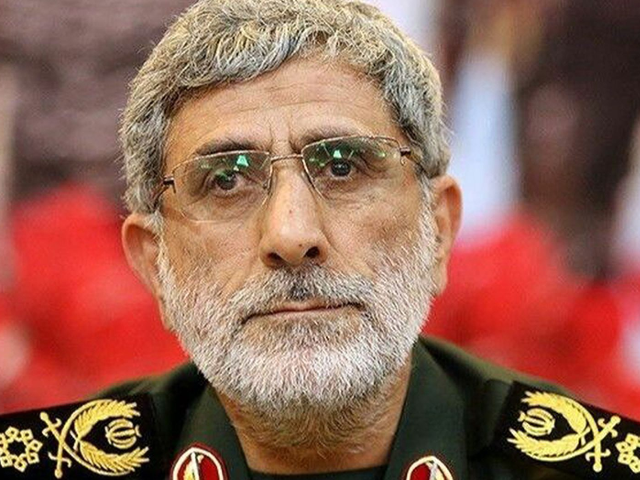Iran’s Supreme Leader Ayatollah Ali Khamenei announced Friday that he had appointed Brigadier General Esmayeel Qaani to replace former terror chief Qasem Soleimani, whose tenure the United States ended with an airstrike on Friday.
Soleimani’s formal title was head of the Quds Force, an “elite” terrorism unit within the Islamic Revolutionary Guard Corps (IRGC), which Washington branded a foreign terrorist organization last year. Soleimani was largely responsible for running the Iranian takeover of Syria, flooding Baghdad with pro-Iran militias, emboldening Shiite Houthi terrorists in Yemen, and otherwise spreading Iran’s military influence by attacking civilians.
Following the announcement of his death, the Pentagon said in a statement Soleimani “was actively developing plans to attack American diplomats and service members in Iraq and throughout the region.” Soleimani was believed to be involved in the failed siege of the U.S. embassy in Baghdad this weekend. Prior to that, his latest operation was to help Baghdad kill civilians protesting against Iran’s takeover of their government.
According to the Fars News Agency, an Iranian regime outlet, Khamenei said Qaani, formerly Soleimani’s deputy, was “one of the prominent commanders during the eight years of Sacred Defense [the Iran-Iraq War] and has been accompanying martyr General Soleimani in the past several years in the region.”
“Following the martyrdom of the glorious general Qasem Soleimani, I name Brigadier General Esmail Qaani as the commander of the Quds Force of the Islamic Revolution Guards Corps,” Khamenei said. “The plan of the Force will exactly be the same as the plan during martyr Soleimani’s tenure.”
Radio Farda added that Qaani played a significant role alongside Soleimani in the Syrian Civil War, which Iran largely fought on the part of dictator Bashar al-Assad. Soleimani and his Quds Force are believed largely responsible for strategies to violently crush civilian opposition to Assad while American forces and Kurdish allies went to the front lines against the Islamic State elsewhere in the country. Iran has always insisted that it fought ISIS in Syria, though Iranian forces and Afghan refugees forced to fight largely stayed in rebel strongholds.
Assad said following Soleimani’s death that he “will not forget that he stuck by the side of the Syrian Arab army … The memory of the martyr Soleimani will remain immortal in the conscience of the Syrian people.”
Qaani received little public attention prior to his rise to run one of the IRGC’s deadliest terrorist cells. Qaani made some public statements carried by sites such as the Iran Project. In 2013, for example, he publicly claimed that the United States “supervised” and “supported” the training of al-Qaeda terrorists, a common Iranian regime conspiracy theory. Two years later, the site documented his remarks supporting the terrorist organization Hezbollah and stating that “the pure blood of the international martyrs of Islam … would bear fruit soon.”
In 2012, the American Enterprise Institute published a profile of Qaani amid rumors that, following the protests against the regime in 2009, regime officials would seek to turn Soleimani into a popular politician. Author Ali Alfoneh noted that, relative to many of the ayatollahs and older religious scholars, Soleimani could be sold as “unifying figure” and “the hero from the war with Iraq” in the upcoming rigged presidential elections.
Alfoneh described Qaani as “uncharismatic and a less distinguished military commander than Suleimani,” but essentially good enough for the job. He noted that, at the time, Qaani “direct[ed] the IRGC QF’s activities in Afghanistan, Pakistan, and central Asia” and appeared to share “Suleimani’s ability for improvisation in military operations.”
Alfoneh added that reports placed Qaani’s son amid anti-regime protesters on college campuses in 2009.
Qaani himself has not made any public statements at press time.
Soleimani died in Iraq alongside Abu Mahdi al-Muhandis, the founder of the Hezbollah Brigades in Iraq. Both are believed to have played a key role in organizing the attack on the U.S. embassy in Baghdad this weekend and planning further attacks. The Hezbollah Brigades, a terrorist militia, are a part of the Popular Mobilization Units (PMU/PMF), currently a legal wing of the Iraq armed forces.
As news of their deaths spread in Baghdad, hundreds took to the streets to celebrate, given their roles in massacring Iraqi protesters who saw Iran as a colonizing power. Locals reported that Iraq deployed PMF snipers to kill protesters in October; the death toll is believed to be well over 100.

COMMENTS
Please let us know if you're having issues with commenting.